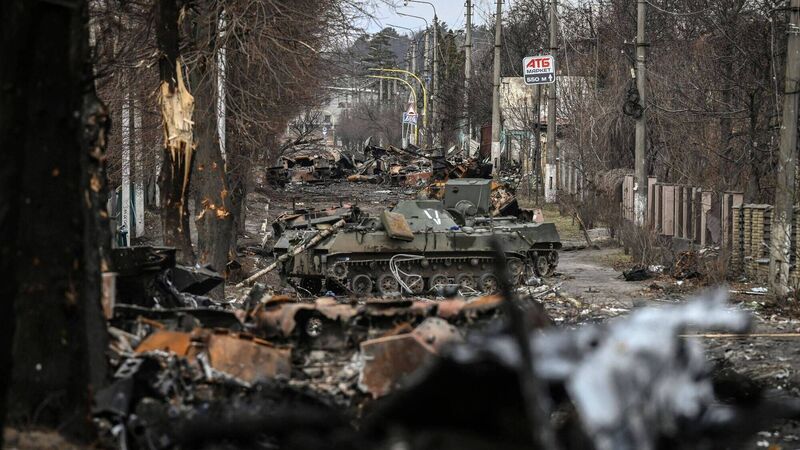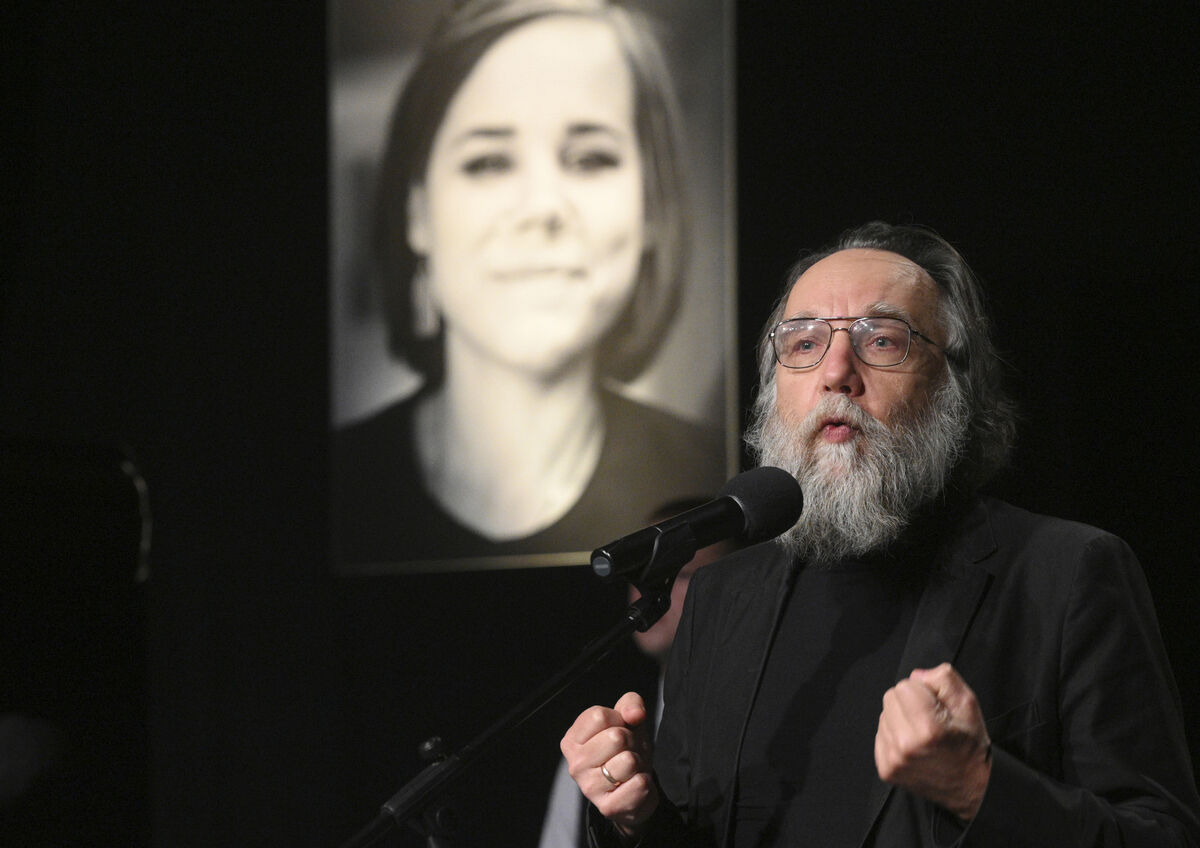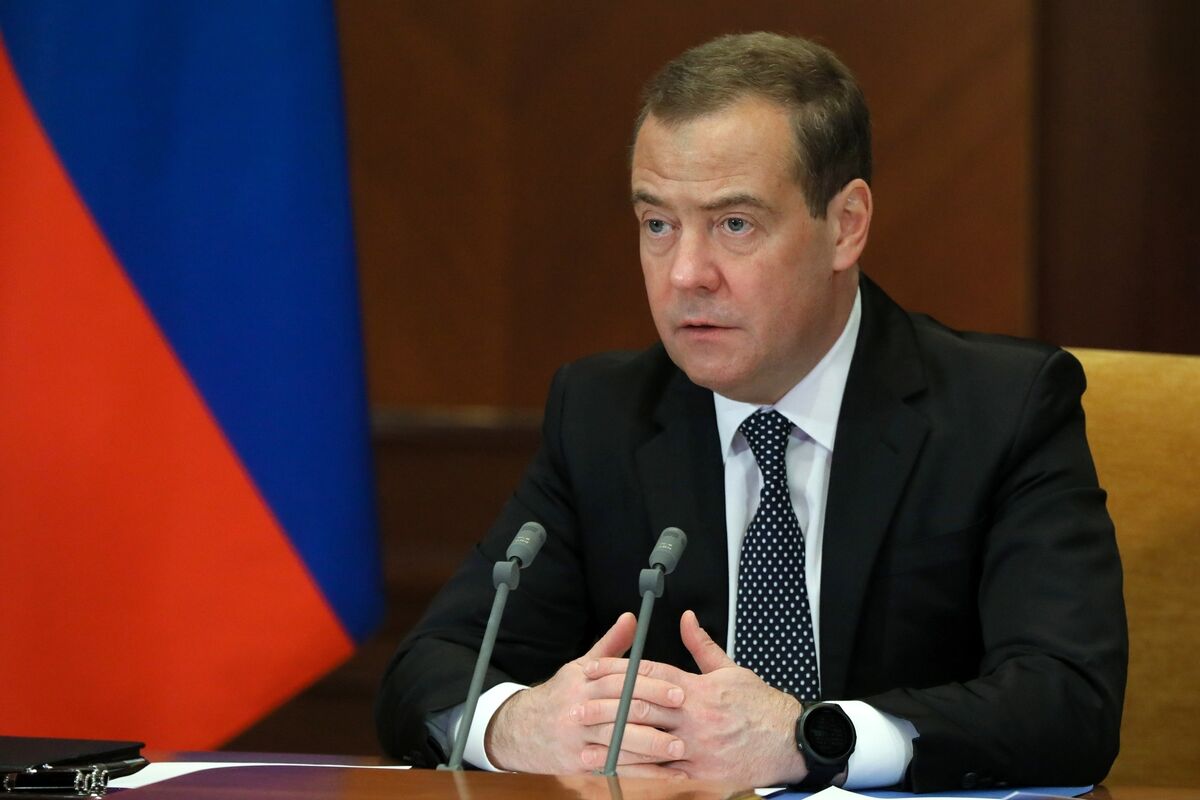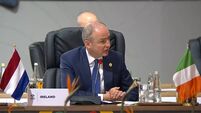Six months in, Russia’s disinformation has laid bare the extent of its lies in Ukraine

In late March, when news of murders and potential war crimes committed by Russian solders in Bucha emerged, Russian state officials and state-backed media went into disinformation overdrive. Picture Aris Messinis /AFP via Getty Images
Days before Russia invaded Ukraine, during a televised (and choreographed) meeting of Russia’s security council, former president Dmitry Medvedev told President Vladimir Putin it was clear Ukraine did not want its two eastern Luhansk and Donetsk regions and that he should recognise the “sovereignty of these territories”.
Hours later, on February 21, Putin appeared on television again in a long and rambling speech that ended with him recognising the breakaway Donetsk and Luhansk People's Republics.
At this time, the pretence of Russia’s plans was still supported and expressed by Medvedev and other officials close to Putin. Soon after this, Russia’s troops would enter eastern Ukraine as supposed peacekeepers to protect Russian citizens whose lives, Russia said, were under direct threat from Kyiv.
Russian forces entered the east and, almost simultaneously, entered the north and the south of Ukraine too. Russia’s “special military operation” was under way and this peacekeeping facade was dropped.
Six months in and the invasion has gone disastrously wrong on most fronts for Russia. To sustain its war effort, the Kremlin has had to rely on an ever-shifting assortment of misleading and false claims and narratives to justify its actions, state-backed media and online accounts to push those narratives, and wider efforts to deny, dispute and deflect its role in numerous atrocities.
With this in mind, it is worth exploring how the Kremlin’s disinformation apparatus has been used to target Ukraine.
Since its annexation of Crimea in 2014, Russia has carried out a sustained and coordinated state-controlled disinformation operation that seeks to influence public opinion among the Russian population, its neighbouring countries and the rest of the world.
For much of 2021 and into 2022, there was much posturing from the Kremlin over claims of aggressive Nato expansion and that Russia was now “encircled by enemies” and needed to defend itself.
Then, as the end of February neared, commentary shifted towards the need to protect the Russian-speaking populations of the Donetsk and Luhansk regions.

Suspected acts of sabotage and false flag events in both regions served as provocation in eastern Ukraine and led to local pro-Russian separatist leaders publicly pleading with Moscow for help, all aided and amplified on Russian state-backed media. The pretext was set and so, the “special military operation” was launched..
When the full scale of the invasion became evident and narratives concerning the east no longer sufficed, we then saw a grand theory of Russia’s aims start to emerge.
Though mostly a meaningless slogan designed to stir up support at home and cast their mission in the same light as the Soviet Union’s resistance to Nazi Germany, it also revealed much of the genocidal intent of Russia at wiping out or “liquifying,” as the Russian term translates, modern-day Ukraine.
Efforts have been made at the highest level to stymie Kremlin disinformation online, but how effective have they been?
On March 2, the broadcast capabilities of and access to RT (state-backed Russia Today) and its various language versions were suspended within EU member states.
Despite this, however, according to analysis from my colleagues at the Institute for Strategic Dialogue, a non-profit that researches disinformation, hate and extremism online, content from RT is still accessible via different types of mirror websites and alternative domains that are providing loopholes for RT content to reach the EU information space.
The full breadth of these mechanisms was perhaps most evident in late March after Bucha, when news of murders and potential war crimes committed by Russian solders emerged. Soon after, Russian state officials and state-backed media went into disinformation overdrive.
Attempts to deny what happened reached Irish shores when the Russian Embassy tweeted out a statement saying “there are no facts” to support allegations of Russian involvement in the atrocities of Bucha, going on to dispute the timeline of events.
Other government officials amplified claims from pro-Kremlin blogs and social media users that alleged “manipulated” media was used in reporting from Bucha by news organisations like the , when in fact such reporting was key to debunking these deranged and immoral claims.

Writing about Ukrainians in June, Dmitry Medvedev wrote:
Gone is the talk of sovereignty and peacekeeping.
Prior to the invasion, Medvedev was one of Putin’s cheerleaders, who willingly spread dubious claims to support the president’s aims in Ukraine.
Confronted with numerous battlefield failures, a resilient Ukrainian defence and mounting evidence of Russian-orchestrated atrocities, it now appears as though for Medvedev and others like him, the fallacy of the Kremlin’s disinformation has laid bare the full extent of their lies in Ukraine.
And yet, signs suggest this is not a tactic the Kremlin will shy away from any time soon.
As I write this, details are still emerging about the weekend killing of Darya Dugina, the daughter of Putin’s ultra-nationalist ally Alexander Dugin, in a car bomb on the outskirts of Moscow.
Already, the FSB, Russia's federal security service, has stated that Ukraine was behind the murder, claimed the suspect is a member of the Ukraine’s security services and said the assassin’s car used Ukrainian licence plates.
It is not impossible but the claims certainly lack credibility. State-linked media have gone a step further and claimed the suspect is a member of the Ukrainian extreme right-wing nationalist Azov regiment.
It may sound like a fairy tale but these could be the opening pages in a new chapter for Kremlin disinformation used to target Ukraine.
















